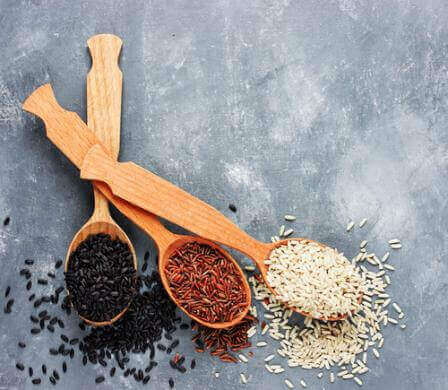3 Reasons to Try Black Rice
Not a brown rice fan? Black rice may make a whole grain lover out of you yet.
Monica Reinagel, MS, LD/N, CNS
Listen
3 Reasons to Try Black Rice

But my discovery of black rice (sometimes called Forbidden Rice) has changed everything. Like brown rice, black rice is a whole grain, with all of the fiber-rich bran and nutritious germ intact. In fact, black rice has even more fiber (and protein!) than brown rice.
But where black rice really shines is in its antioxidant content. The deep pigmentation of black rice (which is actually a very dark purple) comes from anthocyanins, the same compounds that give blueberries their color—and health benefits.
Anthocyanins help protect your heart and brain, lower your cholesterol, and may even guard against cancer and dementia. In fact, anthocyanins may be responsible for many of the health benefits attributed to diets high in fruits and vegetables.
Black rice is (by far) the richest source of anthocyanins of any grain. Take that, brown rice.
How Does Black Rice Taste?
Like brown rice, black rice is chewier and denser than white rice. But it really doesn’t taste like either white or brown rice. It’s plumper, almost juicy. And its flavor is more robust and complex. If you can imagine it, it’s almost like a cross between brown rice, black beans, and huckleberries. (Black beans and berries are both good sources of anthocyanins, come to think of it.)
OK, that might not sound all that appealing but trust me on this: While choosing brown rice over white rice always feels like a bit of a sacrifice to me, black rice feels like a big upgrade!
Keep reading to learn how to cook black rice …
How to Cook Black Rice
The recipe that made me first fall in love with black rice was a salad made with cooked black rice, roasted butternut squash, pomegranate seeds, toasted pecans and slivered scallions, with a maple-lemon dressing.
Although the result was spectacular, it did involve an awful lot of chopping and other prep work. I still make it sometimes and if you need a show-stopping dish for company or to impress the heck out of everyone at your next pot-luck, bookmark this recipe.
But you don’t have to work that hard every time you want to enjoy black rice. You can toss cooked black rice with whatever you’ve got on hand: raw or roasted veggies, leftover cooked chicken or tofu, dried or fresh fruit, chopped nuts, or herbs. Drizzle with a bit of oil and vinegar, if you like. Serve it as a side dish, main course, or pack it for your lunch.
How to Cook Whole Grains Using the Pilaf Method
You can also cook black rice using a pilaf method–and if this technique is not yet in your repertoire, it needs to be. It works with virtually any type of whole grain.
You start by sautéing some vegetables–such as onion, carrot, celery, fennel, garlic, or any combination of these—with a little oil in a large skillet that has a tight fitting lid. I use a lot of vegetables in my pilaf because…well, you know how I feel about vegetables. I’m usually aiming for equal parts grain and vegetable in the finished dish. That means starting out with about twice as much chopped vegetable as dry rice.
When your veggies are soft, season with some salt and pepper and then add one cup of dry rice (or any other grain) and continue to saute for another 3-4 minutes, to toast the grains. Then you add water or stock, bring to a boil and then cover the pan, turn the heat to low, and cook until the liquid is absorbed and the grains are tender.
How much liquid you add and how long you need to cook it depends on the grain. For black rice, you would use about 2 cups of liquid per 1 cup of rice and cook for about 30 minutes. If you have a pressure cooker, it’ll take just 10-12 minutes—yet another reason I love my new pressure cooker.
When the grains are tender and the liquid is absorbed, you just fluff it up and serve. If you’re used to making plain steamed rice, mastering the pilaf method will turn that bland side dish into the highlight of the meal. It also sneaks another serving or two of veggies into your day. Sprinkle it with some fresh chopped herbs or green onions or toasted almond slivers and they’re going to be nominating you for a James Beard award.
Where to Buy Black Rice
Black rice is known as Forbidden Rice because it used to be cultivated in small quantities and reserved exclusively for the Emperors of Ancient China. Fortunately, black rice is getting easier to find. You’ll almost certainly find it at health food or whole foods store; any pIace with a bulk grain section will probably have it. And if all else fails, you can buy it online. You’ll spend between $4 and $7 per pound for it, which is more than you’ll pay for brown rice—but still well under $1 per serving.
Have I convinced you to give black rice a try–or perhaps given you an idea for a new way to enjoy it? Let me know what you think or post your favorite black rice recipe below.
Have you ever tried black rice? Let me know. Send an email or post your question on the Nutrition Diva Facebook page. Then, be sure to subscribe to the Nutrition Diva podcast on iTunes, Stitcher, or wherever you listen, so don’t miss a single episode!
Images courtesy of Shutterstock and Monica Reinagel.

